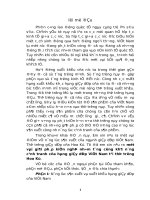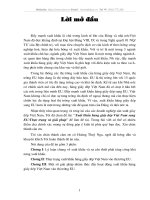Hang Giay Street and Bach Ma temple
Bạn đang xem bản rút gọn của tài liệu. Xem và tải ngay bản đầy đủ của tài liệu tại đây (71.56 KB, 2 trang )
Topic: Hang Giay Street: Talk about the history of the street and about Bach
Ma Temple
Ladies and gentlemen, we have just visited Nguyen Sieu Street as well as Co Luong
Temple. And the next street we will visit is called Hang Giay street. In English, it means
Shoe Street.
In the 17th and 18th centuries, this street was the place for the living and trading of
leather (le) shoemakers. It had a different name during that time. Not until 1947 was the
street officially renamed Shoe Street (Hang Giay Street), which is the name it still bears
today. Currently, the street has two or three shoe shops. Other establishments are grocery
stores, restaurants, cafes, and hotels, which attract a considerable number of tourists.
Moreover, The most famous place to visit on this street is Bach Ma Temple, east of
Thang Long citadel. The main door opens onto Hang Buom street, but from this street
you can see the full length of this temple, and it is also our next site.
So, please follow me and we will get there. Before we go inside, please take off your hat
and have a serious attitude to show respect for the gods as well as our culture.
Ladies and gentlemen, Bach Ma Temple is considered one of the Four Towns of Thang
Long capital. According to the Legend, The Temple was built during the Northern (phía
bắc) colonial period to worship the god Long Do. After moving the capital to Thang
Long, to ease the defense against invaders, King Ly Thai To - the founder of the Ly
Dynasty immediately began building a citadel. However, the strange thing is that no
matter how well the citadel is built and supported, it still collapses. Therefore, he went to
the temple of Long Do god - considered by the people to be the god in charge of Dai La to pray for the land and ask for help. That night, the King dreamed that if he followed the
horse's footprints and built it, the wall would be strong. As soon as the god finished
speaking, a white horse came out from the temple, walked straight from the West, turned
to the East once and then disappeared into the temple. The next day, the King built the
citadel following the white horse's footprint in the dream and it was successful.
Therefore, to gratitude for the support of the god Long Do, he ordained (o:dein) him as a
tutelary (tiu ti lơ ri) god, guarded (ga) the east of Thang Long Imperial Citadel, had a
statue of a white horse carved to worship in the temple, and named the temple Bach Ma
or White Horse temple.
At the end of the 19th century, when the French colonialists came to enlarge the streets,
they did not dare touch the already built parts. Therefore, the appearance of the temple
that remains today mainly has the artistic style of the Nguyen Dynasty as well as the
popular traditional architecture that you can see in most temples and pagodas in Vietnam.
As you can see, the typical architectural feature inside the temple is the entire wooden
house frame with a system of large ironwood columns, the roof support is crafted in the
style of Overlap with careful, sturdy carvings. As you can see above, it's very
complicated, right? To describe it in the most understandable way, do you know Lego?
How do we install it to create a solid axis for the whole statue? Simply press the two
pieces together so that they fit, right? This structure is the same. It is assembled without
nails or screws, but is held together by a complex lattice of stiles and rails and a
combination of mortises and tenons so that the wooden columns fit tightly together.
The main hall worships the statue of Bach Ma, right behind is the forbidden palace,
where the god Long Do is worshiped. And the houses behind are places to worship the
Mother Goddess. Currently, this place still preserves many precious artifacts of great
historical value such as bronze bells, palanquins (pa lừn kin), and stele recording
contributions to the construction and repair of the temple over the past 1,000 years.
Ladies and gentlemen, I have just introduced you to the history of Hang Giay Street and
discovered the Bach Ma temple. Do you have any questions? If not, so It’s time for you
to freely visit this Temple. After 5 minutes, please come back to this situation and we will
move to the next side. That’s Hang Buom street.









